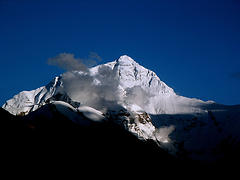
Mount Everest has lost a lot of its intrigue since Sir Edmund Hillary and Tenzing Norgay reached the summit in 1953. Indeed, it’s become a big business in Nepal: Between 1998 and 2001, 560 people reached the “top of the world”; last year Pemba Dorjie Sherpa set a new record by making the climb — five miles straight up — in 8 hours and 10 minutes.
Still, it’s perilous, particularly in the “death zone” above 26,000 feet. Hundreds have died, and most of the corpses remain where they fell, frozen solid.
One of those bodies may hold some astounding evidence — proof that the summit was reached 29 years before Hillary’s achievement.
In June 1924, two British climbers, George Mallory and Andrew Irvine, had climbed to within a few hours of the top. They were using oxygen, which doubled their speed; their geologist reported seeing them climbing “with great alacrity … near the base of the final pyramid” shortly after noon. But the climbers were obscured by mist, and vanished. Had they succeeded?
In 1933 one of their ice axes was found above a large snow terrace. This narrowed the search. If the bodies could be found, Eastman Kodak thought it could retrieve “fully printable images” from their cameras, which would presumably show the summit if they’d reached it. (Irvine was an avid photographer.)
At first the mystery only deepened. A Chinese porter told of finding an “English dead” near the terrace in 1975, but he died in an avalanche before he could reveal any details. Then, in 1999, Eric Simonson found Mallory’s body, with rope trauma indicating that the two climbers had fallen together. But there were no cameras, and still no sign of Irvine’s body.
That’s where the mystery stands now. Last year a new effort began to recover Irvine’s body — details are at Mallory & Irvine: The Final Chapter. So far they’ve retrieved some puzzling artifacts, but no clear answer. Stay tuned.
10/15/2024 UPDATE: In September 2024, Irvine’s partial remains were discovered 7,000 feet below Mallory’s. The cameras are still missing.
